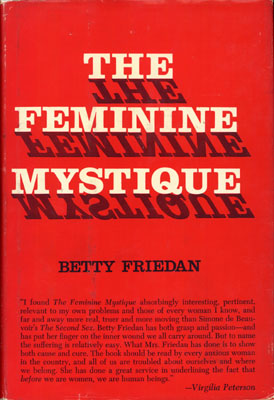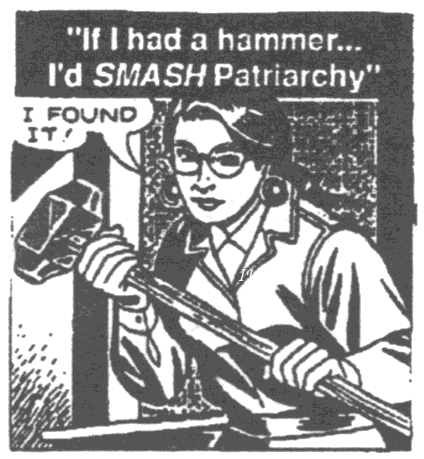|

|
| http://jwa.org/discover/weremember/friedan/antler/feminine_mystique.jpg |
In
1963, Betty Friedan's book The Feminine Mystique revealed the life of thousands of middle class woman, and the oppression
they met. It also revealed the feeling of inactivity and frustration that many college educated women had, due to their inability
to further achieve beyond what the patriarchal society allowed. (Goldfield 890) From this initial spark, the second wave feminist
movement began. The symbols of bra burning and militant feminists were created. The feminist movement is often best defined
by the social battle of the National Organization for Women(NOW), the political battle for the Equal Rights Amendment, and
the continued struggle of women in every layer of society.
The
NOW was founded out of the failings of the 1964 Civil Rights Act. Feminists had lobbied for and been granted an article prohibiting
discrimination by sex for employment. What at first seemed to be a landmark victory, soon became a defeat when the “Equal
Employment Opportunity Commission(EEOC) was formed in 1965 to to enforce the Civil Rights Act”(NOW). While Aileen Hernandez
and Richard Graham battled for equal rights on the EEOC, they were outnumbered 3-2. This lead to the approval of gender segregation
in job advertisement, and in turn did little to change the American work place. In June of 1966, women responded by holding
a massive conference in Washington, D.C., to which hundreds of representatives, including Betty Friedman and Aileen Murray,
attended. They intended to demand the EEOC to uphold what they believed was the intention of the Civil Rights Act, but were
informed that they had no authority. In Friedan's hotel room, an elite group and angrily discussed what to do. That night,
28 women signed up for the temporary organization entitled NOW, with the goal “To take action to bring women into full
participation in the mainstream of American society now, assuming all the privileges and responsibilities thereof in truly
equal partnership with men”(NOW).

|
| http://ffll.de/flugis/04-ag.html |
In
October of 1966 the organization had swelled to 300 members. Officers were elected, with Friedan being declared president,
Kathryn Clarenbach as Chair of the Board, Aileen Hernandez(still a member of the EEOC) as executive vice president, Richard
Graham as vice president, and Caroline Davis as the secretary/treasurer. They adopted an official Statement of Purpose at
the meeting, which read:
“We,
men and women who hereby constitute ourselves as the
National Organization for Women, believe that the time has
come for a new movement toward true equality for all women
in America, and toward a fully equal partnership of the sexes,
as
part of the world-wide revolution of human rights now
taking place within and beyond our national borders."
(NOW Records)
This
document became the doctrine for the organization that would change the rights of women around the world. They committed to
setting up a task force, and to attacking injustice on a national and international level. Their goals were business; not
the lax political style but rather a rapid pace onslaught to forever change the world around them.(NOW)
The
NOW's agenda soon brought them before the United States Congress, and in 1967 they committed to the passage of the Equal Rights
Amendment. Additionally, they intended to repeal all abortion laws, and to gain publicly-funded child care in what became
called the “Bill of Rights for Women”. (NOW) Through the growth of the Women's movement, along with more national
participation, the Equal Rights Amendment was passed in both the Senate and the House of Representatives in March 1972. This
became the proposed 27th amendment of the Constitution. Unfortunately, the political process became the failure point of the
proposed amendment. A seven year deadline was placed on the amendment, as congress had done since the 18th amendment. At first
appearing to be a non-issue, 22 of the necessary 38 states ratified the amendment. But the pace quickly slowed after 1972.
In 1973 eight states ratified the amendment, three in 1974, and one in 1975. By 1976 the amendment had nearly disappeared
and no states ratified. The NOW soon became the flagship organization for ERA
support, but in 1977 Indiana was the 35th and final state to ratify the ERA. (Equal Rights Amendment)
With
the failing of the ERA, the feminist movement began to slow. In 1977, the symbolic end of feminism came with the death of
Alice Paul. (Lewis) The organization saw the decrease in political power, as the feminist movement stalled. In 1981, women
saw the successful appointment of Sandra Day O'Connor to the US Supreme Court by Ronald Reagan. In 1981 the “Last Walk
for ERA” raised nearly a million dollars to to support the ERA, which would fail soon after. The battle by the NOW switched
to congressional lobbying, fighting heavily against continued restrictions on abortion. In 1983. Continued fighting for abortion
rights defined the NOW in the 1980's. In 1985, chapters of NOW held around the clock vigils at 30 clinics in 18 states to
prevent violence. In June, the NOW hosted a national march in Washington to fight for women's abortion rights, counter to
that of the Catholic Leadership.(NOW History)
In
modern times, the NOW fights for international women's rights, and continues the battle for abortion against the Pro-Life
campaigns. They also battle to remove the stereotypes that existed on the second wave feminist movement.(NOW) NPR reported
in 2008 that the old image of “Bra Burners” was a fallacy. Started during the 1968 Miss America pageant, the women
removed their bras and threw them away. They had intended on burning them, but the police would not allow fires on the boardwalk
where the group was located. Rather, the women threw bras, mobs, girdles, pots, pans, and “Playboy” magazines
into a big garbage can, as all the items were “instruments of female torture.”(Greenfieldboyce) This stereotype
lives on today, but the true feminist movement is not defined by the militant images of the media. Rather the feminist movement
was part of a multi- organizational effort to successfully pass the Equal Rights Amendment, meant to guarantee the rights
of all citizens.
|

